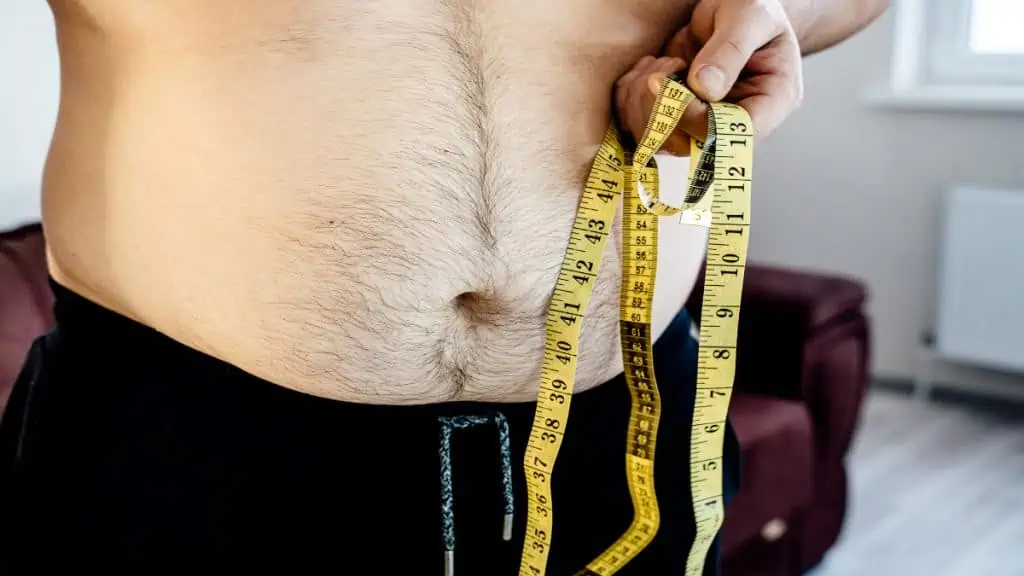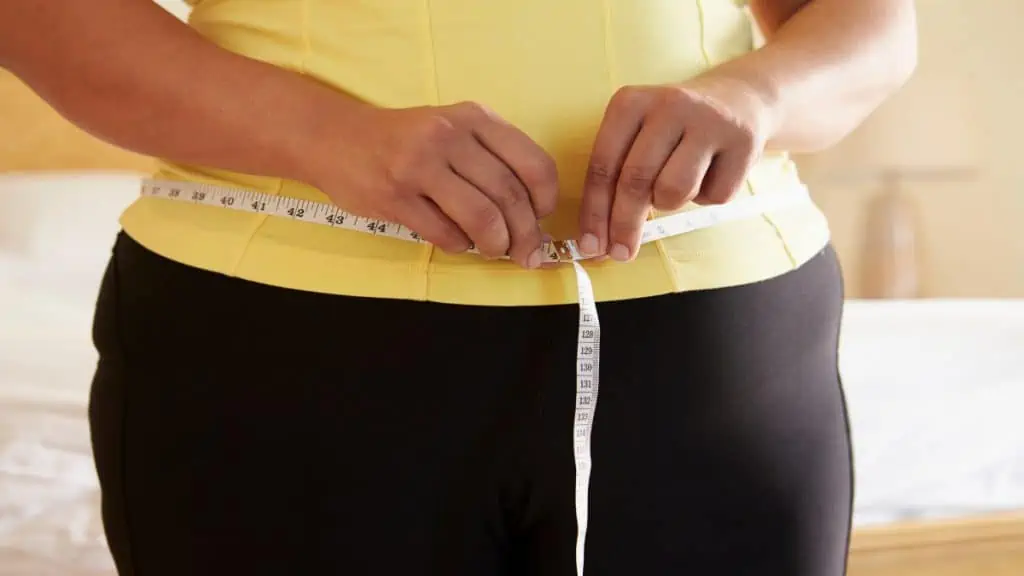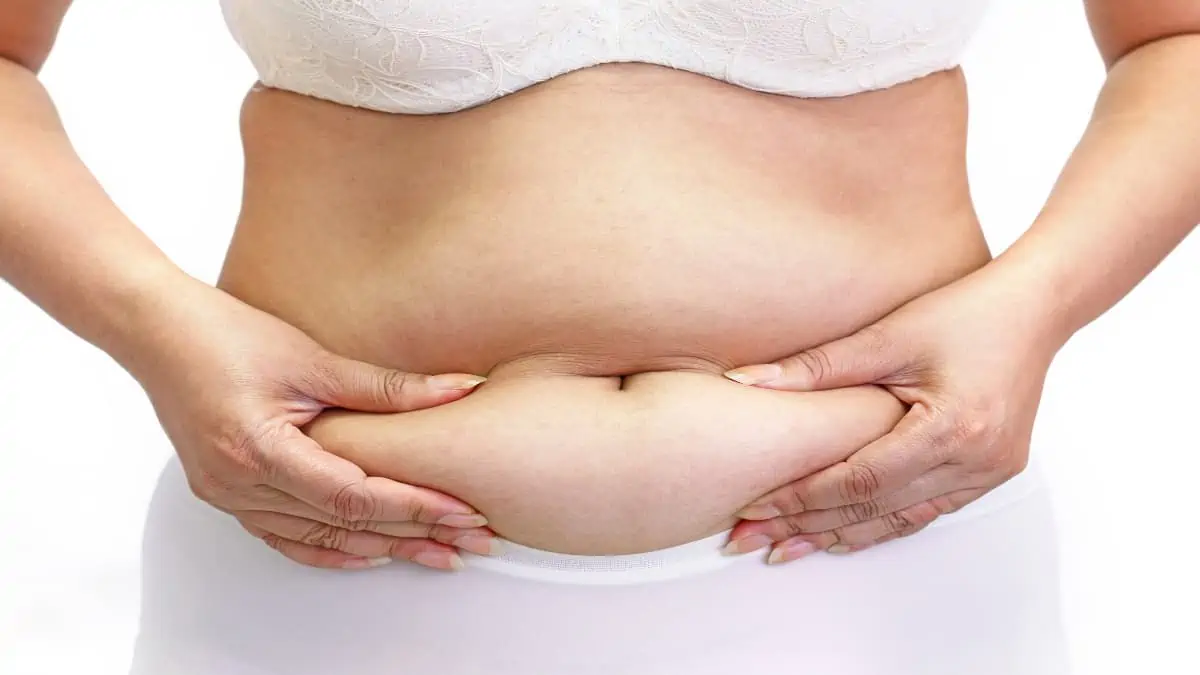40 inches is the average waist size for an American man and two inches bigger than average for a woman. But how exactly does having a 40 inch waist affect your short-term wellbeing and your long-term health?
We set out to answer this question using the latest obesity and body measurement research. You can keep reading to see our findings and read our conclusions, or you can explore the articles below to learn about other common waist measurements and their effect on health.
- 39 inch waist
- 41 inch waist
- 42 inch waist
- 43 inch waist
- 44 inch waist
- 45 inch waist
- 46 inch waist
- 47 inch waist
- 48 inch waist
- 49 inch waist
What does a 40 inch waist look like on a woman?

What does a 40 inch waist look like on a woman? Considering that a 40 inch waist is larger than average for a woman, such a measurement will likely look quite big on a female.
But even though you can have a 40″ waist and still be happy with your body, it’s not good to have a 40 inch stomach if you want to live in good health. Indeed, cardiologist Craig Peters notes that—as a woman—if your waist size exceeds 35 inches, then you have an increased risk of developing conditions like heart disease, high blood pressure, and diabetes. [1]
Of course, you don’t need a skinny waist to look great and feel healthy. However, since a 40 in waist is 5 inches above the cut-off point, it’s a good idea to lose some belly fat by eating less and performing more exercise.
What does a 40 inch waist look like on a man?

A 40 inch waist will look big on a man because such a measurement is indicative of a male having excess stomach fat. When a man has a 40″ waist or larger, he’s at a high risk for heart disease and diabetes and should seek to reduce his stomach size and BMI. [2]
Since men typically carry more muscle mass than women, it’s true that a higher proportion of a male 40 inch waist will consist of lean mass, which is to say, the ribcage and abdominal muscle mass.
However, even bodybuilders with a thick waist rarely have a 40 inch waistline. As such, even if you do have well-developed abs and obliques, it’s highly unlikely that your abdominal mass is primarily responsible for your 40 inch belly.
How big is a 40 inch waist for men and women?

For both men and women, a 40 inch waist is very big and puts you at a high risk—not merely an increased risk—of developing chronic diseases like type 2 diabetes and heart disease.
Of course, a 40 in waist will look bigger and smaller on certain body types.
The taller that you are, the smaller that your 40″ waist will look. This is because taller people have more bone mass and a longer torso (if you have a long torso rather than a short torso, then your waist represents a smaller portion of the overall surface area of your torso/body).
Since a 40 inch waist is big, it’s not surprising that such a circumference measurement can even lead to conditions like sleep disordered breathing. Indeed, researchers in this field note that an abnormal waist size for both men and women is 40 inches or more. [3]
The good news is that, with a 40 inch waist size, you’re technically relatively normal (but likely not optimally healthy) in terms of measurement based on US anthropometric data. As such, you don’t need to despair just because you have an excessively big stomach; you can lose belly fat by eating healthier and following an exercise regime of moderate intensity.
How to reduce your 40 inch belly

Successful weight loss necessitates that your body is in an energy deficit. This means that if you want to drop belly fat, you need to consume fewer calories than your body needs to maintain its weight.
In theory, it’s possible to eat junk food and still lose weight because weight loss comes down to a relatively simple calories in vs calories out equation.
However, health isn’t measured by numbers on the scale or inches on the tape measure. There are plenty of slim people who are unhealthy because they eat processed junk food.
So, to lose weight and improve your health, you should stick to healthy whole foods. For fat, eat protein-packed oily fish, avocado, and nuts. For carbs, eat potatoes, lentils, oats, and quinoa. For protein, eat beans, lean meats, fish, eggs, and dairy. Of course, this list is far from exhaustive, but the examples should give you some inspiration for your waist-slimming meals.
Not only are whole foods more nutrient-dense than junk foods, but they’re also way more filling and versatile. So you’ll feel fuller for longer (which will reduce your cravings) and get way more cookery freedom simply by switching to healthier food options.
The verdict: Is it bad to have a 40 inch waistline?

Although it’s possible to be happy with your body while having a 40 in waist, such a waist size is too big for you to live in your best health.
Since no responsible health practitioner would advise maintaining a 40 inch waist, your best bet is to follow a sustainable diet and exercise regime that enables you to lose weight slowly over the coming weeks and months.
You needn’t live in the gym to reduce your 40″ waist, either. Walking in the park gets you out in the fresh air and can burn quite a few calories without you feeling like you’re doing exercise.
Other than that, just make sure to avoid processed foods because, being more calorie-dense, they promote weight gain, which is the opposite of what someone with a 40 inch waistline should be striving for.
References
- Peters, C. (2018, July 20). Ask a Doc: How your waist size affects your health. USA TODAY. https://eu.usatoday.com/story/life/allthemoms/2018/07/20/how-your-waist-size-affects-your-health/783178002/
- Diabetes UK. (2011, October 7). Survey reveals men are off the mark when they measure up. https://www.diabetes.org.uk/about_us/news_landing_page/survey-reveals-men-are-off-the-mark-when-they-measure-up
- Davidson, T. M., & Patel, M. R. (2008). Waist Circumference and Sleep Disordered Breathing. The Laryngoscope, 118(2), 339–347. https://doi.org/10.1097/mlg.0b013e3181587d7c

